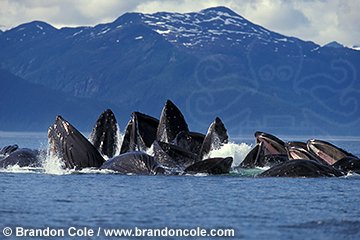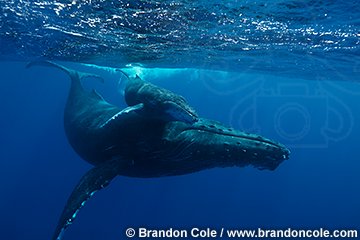|
photos of humpback
whales
To see more humpback whale
pictures, click here
|

humpback whale breaching photo |

humpback whale photographs tail flukes
at sunset |

bubble-net feeding humpback whale
picture |

humpback whales underwater photos of
mother and baby |
|
common
name |
Humpback
Whale |
| scientific
name |
Megaptera
novaeangliae |
| range |
circumglobal,
tropical to polar |
viewing
hotspots |
Alaska
USA, Hawaii USA, Tonga, Dominican Republic |
| habitat |
coastal,
open ocean |
| size |
to
50 feet (15m), 40 tons |
| diet |
krill,
schooling fish |
| trivia |
wing-like
pectoral fins up to 1/3 body length; sings complex songs; unique tail
fluke markings; intensely physical battles between males when competing
for females |
|
The
Humpback Whale, Megaptera novaeangliae, is one of the most charismatic
whales in the sea. Acrobatic, easily recognizable, and found in many
locations in both hemispheres, it is a popular target of the
whale-watching industry. Growing to just over 50 feet in length and
weighing in at 30 to 40 tons, it is a large member of the Balaenopteridae,
but certainly nowhere near the size of the blue and fin whales.
Scientists
have been studying the humpback whale extensively for decades, researching
among other things its 1) impressive yearly migration- up to 10,000 miles
round-trip- from summer feeding grounds in high latitudes to mating and
calving grounds in the tropics; 2) eerily beautiful mating songs, the
animal kingdom’s most complex melodies; and 3) communal bubble-net
feeding behavior. The latter is truly one of nature’s most amazing
spectacles, a summer-long "all you can eat Alaskan buffet." Up to
twenty whales circle underneath a school of herring, exhaling streams of
bubbles which, upon rising, entrap and disorient the fish. Swimming
upwards into the stunned mass of fish, the leviathans open wide and gulp
hundreds of gallons of sea water and the herring snack it contains,
erupting from the surface with cavernous maws agape.
Slow to
recover from heavy losses in the early twentieth century, especially from
the Antarctic whaling fleets and shore stations in the Southern
Hemisphere, roughly ten percent of the pre-whaling era population estimate
of 125,000 survive today. Sadly, this earns an "endangered
species" badge even in our age of enlightenment.
One of the
continuing mysteries in whale watching circles is exactly why whales jump
clear of the water, or "breach". Does the thunderous splash
resulting from a 40-ton bellyflop serve as some form of communication with
other nearby whales? Could breaching be a threat display, or a show of
dominance? A means of knocking off itchy barnacles, parasites and other
skin irritants? Or could it be simply for the sheer fun of it? My guess is
that all are possible explanations- especially the last! We honestly know
so very little about these giants of the deep and their mysterious ways,
but everything science has uncovered hints that cetaceans are intelligent,
social animals, capable of a remarkable array of complex behaviors. |
|
| KEYWORDS
humpback whale, humpback whales, humpback, humpbacked, whale, whales,
Megaptera novaeangliae, cetacean, cetaceans, marine mammal, marine
mammals, rorqual, rorquals, balaenopteridae, endangered, baleen,
breaching, jumping, tail, flukes, feeding, bubble net, underwater,
behavior, photo, photos, photograph, photographs, picture, pictures,
stock, photography, marine |
|